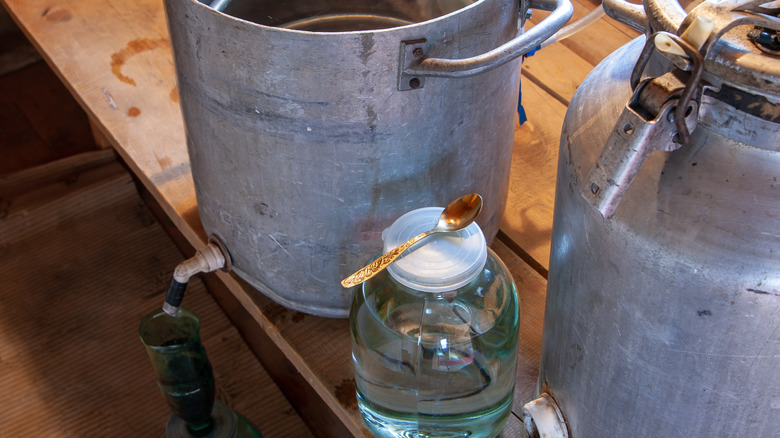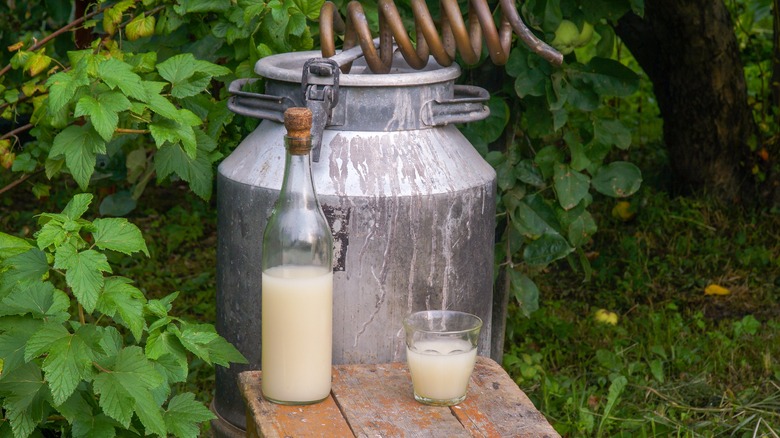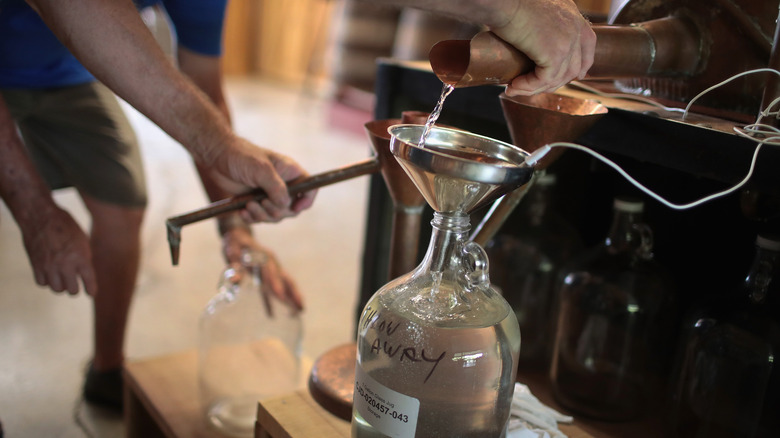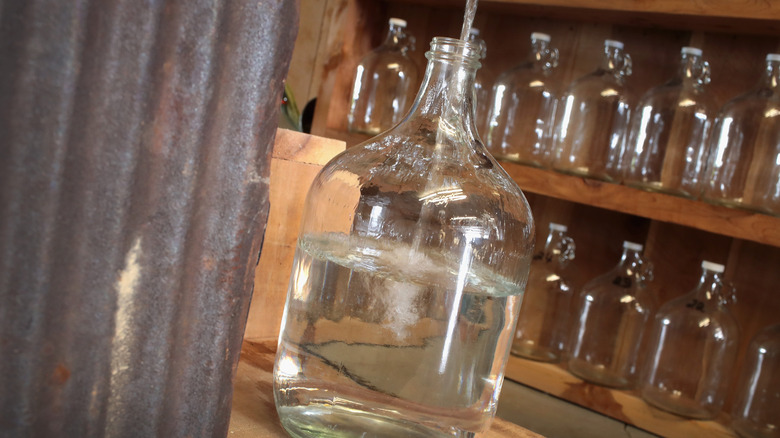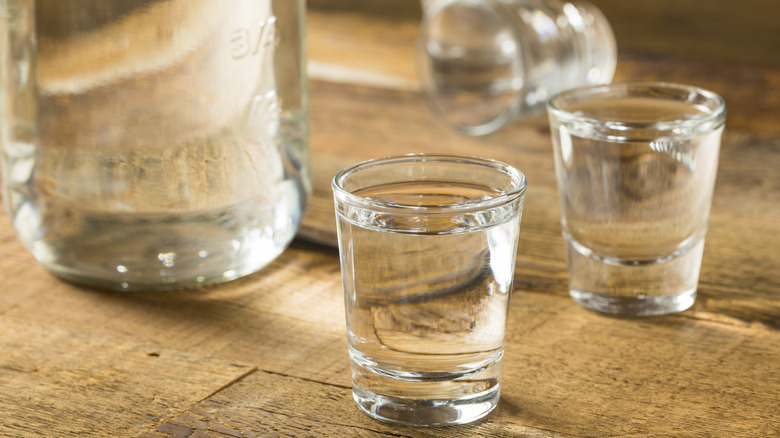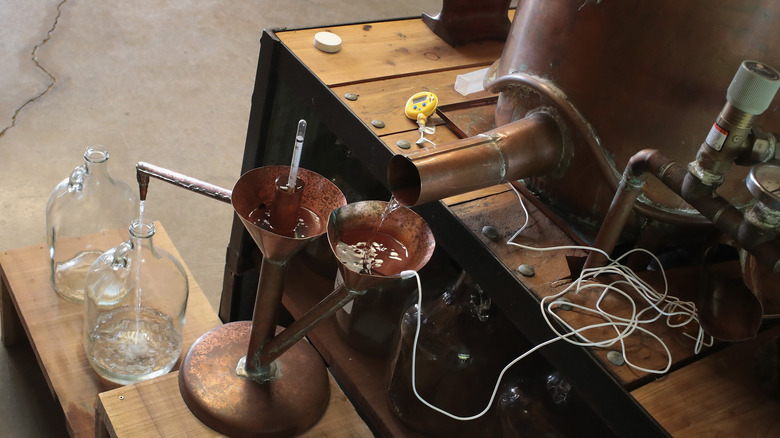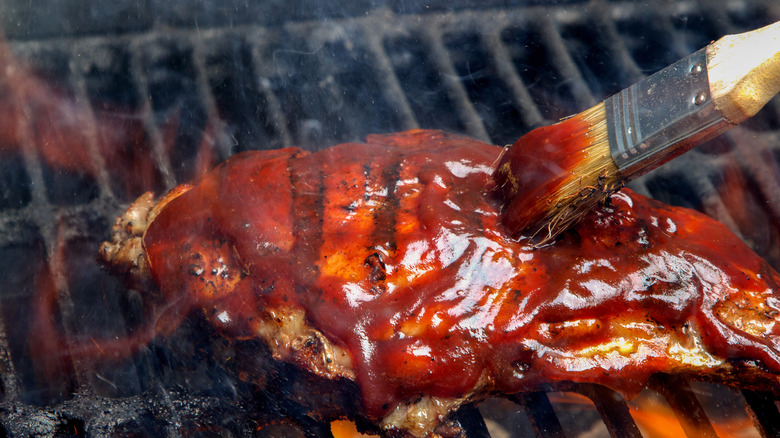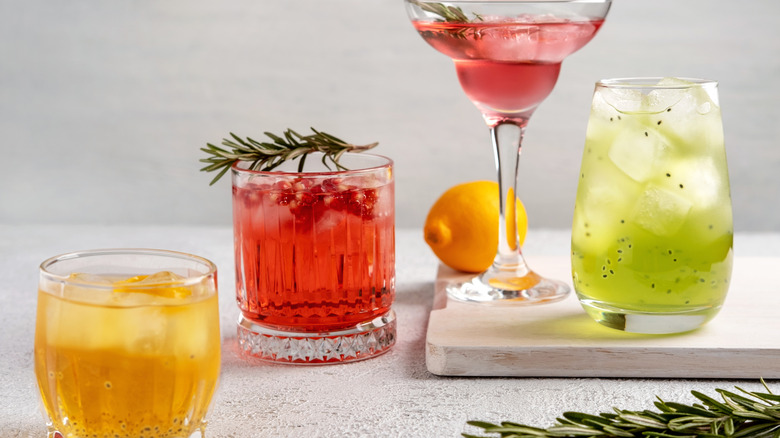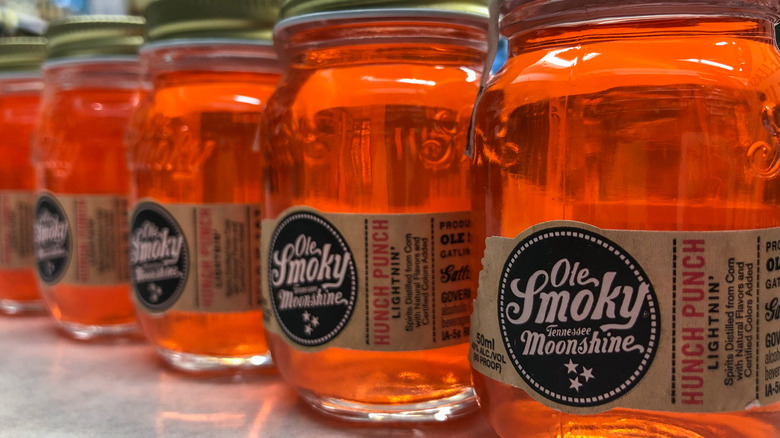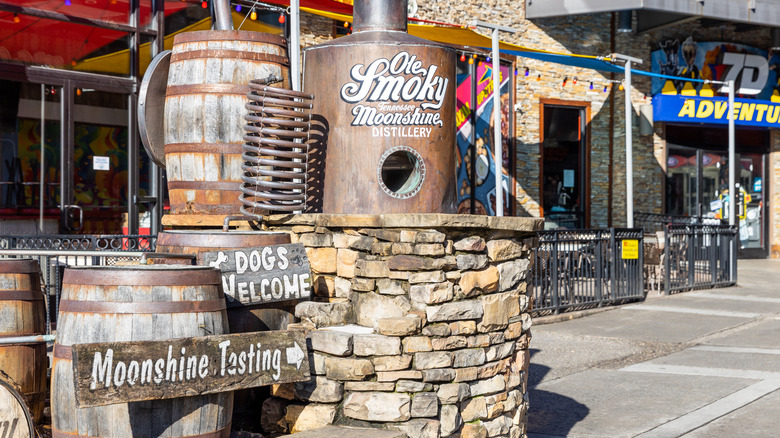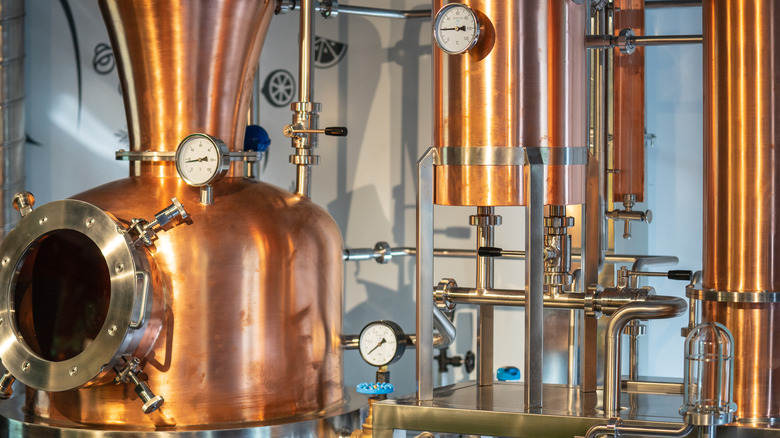What Is Moonshine And Is It Legal?
Even if you've never tasted moonshine or don't know if you'd recognize it, you probably know it has a dangerous reputation. Indeed, the main thing most people know about moonshine is it's not supposed to exist: According to the Cambridge Dictionary, it can simply be defined as "alcohol that is made illegally." And, as is often the case with forbidden pleasures, the very fact that we're not supposed to have moonshine makes it all the more intriguing. As a case in point, the Discovery docudrama "Moonshiners," which follows a group of proud Appalachian moonshine makers as they attempt to keep distilling while evading law enforcement, has run for 12 seasons — revealing a lasting fascination with moonshine and the rogue distillers who make it.
But as any of the titular characters on "Moonshiners" can tell you, contrary to the claims of Cambridge Dictionary's lexicographers, not just any unlicensed booze qualifies as moonshine. A rural American descendant of whiskey, traditional moonshine is a distilled liquor. It's generally clear and unaged (since hiding large barrels of aging liquor from law enforcement for years at a time was neither practical nor possible). But beyond that, ingredients and flavor profiles can vary widely. Moonshine is not champagne, and there's no official body that defines what it can and cannot contain. Today, there are even legal forms of moonshine. Moonshine has a long and messy history, so let's sort out the details.
What is moonshine?
While most dictionaries define moonshine simply as illegally produced alcohol, the term is most commonly used in the U.S. to refer to illicitly distilled spirits rather than other fermented beverages such as beer or wine. Beer and wine are made by simply fermenting the base ingredients (barley or fruit) before adding additional flavorings and/or aging the beverage to develop its flavor. Distilled spirits are made by separating the water from the alcohol following initial fermentation. Thus, distilled spirits comprise the alcohol separated out through this process — along with any flavors it may have picked up from the fermented ingredients.
Because of their high alcohol content, distilled spirits have the advantage of a long shelf life, making them a more practical (and potent) option for DIY drink makers and drinkers in the backwoods of rural America, where moonshine-making originated. Many traditional spirits (such as whiskey and bourbon) are aged several years to develop and smooth out their flavors before they're consumed; traditional moonshine is considered ready for drinking immediately after it's made.
How is moonshine made?
Simply put, traditional moonshine made in the rural U.S. is made by distillation. For a long time, corn was the most commonly used ingredient to ferment moonshine;some farmers discovered that making and illicitly selling moonshine was an effective way to get more ROI from their crops. However, moonshine was and is made from a range of other ingredients as well, including barley, rye, wheat, and even sugar. (So-called sugar shine is a traditional under-the-table specialty of the low country of Georgia and the Carolinas.)
The basic distilling process requires four steps. First, take the grain or other fermentable of your choice and simmer it with water to form a mash. Next, add yeast and allow the mash to ferment. Next, put the fermented mash into a still to separate out the alcohol from the rest of the liquid. The traditional pot stills used by most moonshiners consist of a pot in which the mash is heated, causing the alcohol to start evaporating before the rest of the water-based mash itself steams. A condenser over the pot catches the alcoholic vapors, which turn back into a liquid form and drip into a holding container. From here, it can be distilled again to make an even stronger beverage or cooled for consumption. Fun fact: The three X's on moonshine jugs in old cartoons indicate the number of times the moonshine has been distilled. Three X's means three times through the still, thus strong moonshine of higher quality.
Is moonshine illegal?
If you've been hearing a lot about moonshine lately or even seeing bottles labeled "moonshine" in stores, you might be confused. Isn't moonshine supposed to be illegal? If it is indeed illegal, then what's going on at the local liquor store? And if it's not, why is there still a TV show about backwoods distillers dodging ATF agents? The answer comes down to licensing. Legally, one needs a license to distill alcoholic beverages in the U.S. The licensing and permitting process is neither easy nor cheap — even if your application (it's long) is approved, the plant permit fee alone can be up to $4,000 in some states, like Florida.
One reason for this requirement is health and safety: Although bad homemade beer or wine is merely disappointing, improperly distilled spirits can potentially cause methanol poisoning. Unfortunately, there's some truth to the stories about moonshine causing blindness. In addition, distilled spirits are subject to taxation. (Taxation of distilled spirits started after the end of Prohibition, which was when backwoods moonshiners went from being merely home distillers to outlaws.) In short, both legal and illegal forms of moonshine exist. So although both commercial moonshine manufacturers and your West Virginia cousin offer up mason jars of unaged spirits, only the former has a drawer full of permits — and pays taxes on every jar sold.
Moonshine has a long history
In the public imagination, moonshine is a product of Prohibition, when the making and selling of homemade spirits became illegal. This is indeed the point at which moonshine gained its notoriety as an illicit substance, yet home distilling was practiced in the rural U.S. long before that. Settlers of Irish and Scottish descent arriving during the 18th century brought their whiskey-distilling knowledge to the U.S. and quickly adapted recipes and methods for local ingredients. The term moonshine also comes from this period — it was an 18th-century English term for liquor.
Moonshine makers and drinkers were having a great time until 1791, when the federal government imposed a tax on liquor, including homemade moonshine. This did not go over well with moonshiners, and in Pennsylvania, a group of 500 angry distillers and their supporters attacked the home of the local tax collector, sparking a conflict that escalated to include nearly 6,000 people. This conflict, which became known as the Whiskey Rebellion, was followed by the repeal of the tax in 1810. When the prospect of taxation and legal regulation raised its head again during the Prohibition, moonshine again gained notoriety. It also indirectly sparked a sports revolution: Bootleggers who smuggled moonshine by car — and thus had to be fast and agile enough to evade law enforcement — became such adept drivers they began racing each other on their days off for fun. Their races became spectator events in their own right — eventually evolving into NASCAR.
Moonshine vs. bourbon: What's the difference?
Moonshine and bourbon share common roots, which may be why they're often thought of together. Both are distilled spirits with origins in the rural U.S. — early American settlers commonly owned stills and made spirits for their own personal use as well as to barter for other goods. The simplest version of such spirits was moonshine, which was a crude spirit made from whatever grain (or fruit or other fermentable) the distiller had on hand. It was served unaged, often going straight from the still to the bottle to the drinker.
As European settlers became more established in the U.S., so did commercial distilling, and by the 1820s, distillers discovered (it's unclear how) that aging whiskey in charred barrels gave it a smoother and more complex flavor. Commercial distillers continued to refine their methods for barrel-aging their product, which eventually evolved into today's bourbon. Today, bourbon is officially defined as whiskey with a mash bill of at least 51% corn that's aged in charred oak barrels. It has also been legally declared a uniquely American product, meaning it must be made in the U.S. to be legally marketed as bourbon.
What does moonshine taste like?
Traditional moonshine was (and is) made with a wide range of ingredients, from grains including corn, rye, wheat, or barley to other fermentable foodstuffs such as sugar. As a result, its exact flavor profile can vary greatly. But because moonshine is unaged, all forms of traditional moonshine share a few basic characteristics. For one, unlike bourbon or whiskey, which are aged grain-based spirits, traditional moonshine is always clear rather than amber. And no matter what its base ingredients may be, traditional moonshine lacks the oaky or smoky notes that come from barrel aging, along with the smoothness. This gives it a flavor its fans think of as fruity and a bit sweet. But because it's not aged, it can also be a bit harsh, especially if you're used to more refined drinks: Some fans appreciate its potency and burn; others find it off-putting.
Because of its harshness, early moonshine drinkers sometimes doctored their doses with fruit and sugar to improve its flavors. Today, licensed commercial distillers who make unaged distilled spirits have taken the tradition of augmenting moonshine with fruit and run with it — commercial moonshine now comes in dozens of traditional and far-from-traditional fruity flavors, from blackberry to banana pudding.In short, moonshine's characteristic sweet, fruity notes can range from subtle to over-the-top decadent.
How much alcohol is in moonshine?
Moonshine has long had a reputation as a potent drink. This is in part because traditional moonshine is drunk young and doesn't hide its burn. But it's also because, in some cases, the rumors are true — varieties of traditional moonshine can pack a powerful punch. Straight from the still, traditional moonshine ranges from 150 proof (75% alchohol-by-volume) to 190 proof (90% ABV). In contrast, vodka is typically bottled between 80 and 100 proof.
But moonshine comes in a dizzying variety of forms, from old-school, take-no-prisoners backwoods concoctions to fruity, cloying commercial varieties. All of these vary in potency. A popular commercial brand, Ole Smoky Moonshine, for instance, offers 30 different flavors of moonshine, ranging from 100 proof for its Original Plain moonshine down to 35 proof for its White Chocolate Strawberry Cream moonshine. (Apparently, the strawberries and white chocolate displace much of the alcohol.) Purists might question whether such sugary blends even count as moonshine; this range of options shows that you can indeed enjoy moonshine (or something evoking its spirit) without the risk of knocking yourself unconscious.
How to cook with moonshine
Traditional moonshine packs a punch, so it is meant to be sipped in small quantities. This means if you procure a bottle of it, you'll have way more than you can (or should) drink all in one go. But even if you decide it's more of a once-in-a-while drink than a daily sipper, you can still put your bottle of moonshine to good use by cooking with it. The searing notes of traditional moonshine, combined with its high alcohol content, make it a flavor-boosting addition to a number of dishes.
For example, moonshine — including fruit-flavored varieties – makes a great addition to barbecue glazes. Just reduce a bit of the moonshine over medium heat with the other glaze ingredients and slather away — the moonshine will add a noticeable burn of flavor. It also works well as part of the braising liquid for stews and other braised meat preparations since the alcohol helps tenderize the meat. If you want something tart and crunchy to cut the richness of your braise, serve up some moonshine pickled vegetables — just add a splash of moonshine to your pickling brine. For a super-flavorful dessert, add moonshine to your cake batter — your cake will turn out exceptionally moist and flavorful. Want something sweet and crunchy to snack on between meals? Try moonshine caramel corn for a new twist on a classic.
Moonshine cocktails
Historically, rural Americans cherished moonshine because it was about the only option available if one felt like an alcoholic drink. It was valuable enough that producers often traded it for other goods they needed. And even today, consistent with this tradition, it's typically enjoyed straight.
All things considered, today's drinkers have a world of other options for enjoying moonshine. If you enjoy traditional moonshine but find it a bit strong to enjoy on its own, you can make a lighter drink by mixing it with lemonade or Coke. It can also take the place of other liquors in traditional cocktails: For instance, try making a margarita variant with moonshine in place of the traditional tequila or make a mule with moonshine in place of vodka. Other popular mix-ins for moonshine include grapefruit juice, iced tea, beer, and vermouth. And for a fruity cocktail perfect for fall, make this sweet-spicy apple-pie moonshine. A warming mix of apple juice, apple cider, sugar, and fall spices cooked together and blended with moonshine makes a lovely nightcap to top off an autumn dinner party.
Moonshine comes in a variety of flavors
When early American settlers first started distilling moonshine, their options for making it were pretty limited. Any number of grains were historically used, and individual distillers were constrained to what was available and inexpensive for them — typically whatever grain they were already growing as their day job. During Prohibition, however, the number of home distillers exploded since other options for obtaining liquor had closed off — and these new distillers introduced fresh ingredients, including fruit, into their moonshine.
Today's legal moonshine distillers have continued that tradition, concocting a dizzying variety of flavors Prohibition-era brewers probably would not have imagined. Among the flavors offered by Tennessee-based Ole Smoky Moonshine, for instance, are inspired by banana pudding, butter pecan, strawberry and mango margaritas, and buckeye candies (chocolate and peanut butter). Elsewhere in the state, the Tennessee Shine Company offers flavors, including mint chocolate Moon Pie, root beer float, and wild cherry. In addition, commercial moonshine manufacturers also offer fruit (such as pineapple and mandarins) macerated in flavored moonshine, as well as moonshine pickles. But traditionalists have no need to worry — it's also easy to find plain, old-fashioned, corn-based moonshine.
Where to buy moonshine
Even in proud longtime bastions of moonshine-making, such as rural Appalachia, locals have long had mixed feelings about the stuff. The illegality of moonshine, combined with the region's conservative religious culture, meant alcohol production and consumption were relatively secretive affairs. A group of friends on a hunting or fishing trip, far from prying eyes, may share a jar of moonshine, but there wasn't a culture of public social drinking. Essentially, there was no Appalachian equivalent to a neighborhood bar or pub. If you wanted some, you had to know the right people and understand it would only be offered within a close circle of trusted family or friends.
With the emergence of licensed moonshine distilleries, however, it is now easy for anyone — even those without social connections in moonshine country — to sample moonshine. Major liquor stores such as Total Wine and More offer dozens of varieties both in-store and online, as do larger moonshine manufacturers themselves. For those wanting a less-corporate shopping experience (or to taste moonshine as it was originally made without running afoul of the law), there's good news: A number of small legal distilleries were founded by experienced moonshiners who chose to go legit — and many still use the old family recipes that made their reputations.
Nutritional information about moonshine
The high alcohol content of traditionally made moonshine not only helped it become a valued source of psychic relief for early settlers but earned it a reputation for having medicinal properties. After all, there was no denying a shot or two of the stuff could dull any discomfort one might be experiencing. Because of this, moonshine developed a reputation as a cure-all for ailments ranging from colds and flu to stomach disorders. Parents in earlier times also rubbed it onto babies' gums to soothe teething pain (we shouldn't have to tell you what a terrible idea this is). And even today, it's used as a topical antiseptic by some.
But let's get real, nobody today is drinking moonshine for its health benefits. And they shouldn't: Nutritionally speaking, there's not a lot going on. A one-ounce shot of unflavored Ole Smoky Moonshine has 80 calories and also no carbs, fat, or protein. Flavored varieties — especially the cream-based ones — are a bit more substantial. A one-ounce shot of Ole Smoky Some Beach Cream Liqueur moonshine has 100 calories, two grams of carbs, 0.1 grams of protein, and half a gram of fat — so it's not exactly a nutritional powerhouse either. So, unflavored moonshine may be a good drink choice for those on keto diets. However, we shouldn't even try to pretend it's doing us any good nutritionally.
How to store moonshine
Traditional moonshine has a rough-and-ready reputation for a good reason — it doesn't need a lot of coddling. Families that made it simply had it around, "around" being loosely defined. There were certainly no fancy, climate-controlled cellars or liquor lockers involved — a jug or jar of it would simply appear when the occasion called for it.
Thus, if you procure your own stash of legal moonshine today, you don't have to worry too much about protecting it. Plain, unsweetened moonshine, like other spirits, is shelf-stable and perfectly fine stored at room temperature — but avoid storing it in spaces with extreme temperature fluctuations. It's safe to store moonshine in plastic containers (contrary to popular belief, moonshine cannot dissolve plastic). Glass is a safer bet for long-term storage since it won't impart any off flavors to the spirit. Like other spirits, moonshine will maintain its quality longer if stored away from direct sunlight. Sweetened, flavored moonshine, however, requires a bit more care. Sealed, unopened containers of flavored moonshine can last indefinitely at room temperature away from direct sunlight; opened containers should be refrigerated to prevent spoiling and can last three to six months in the refrigerator.
